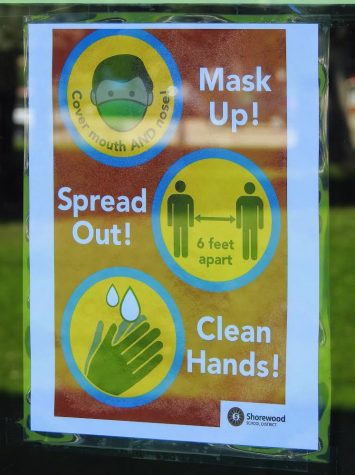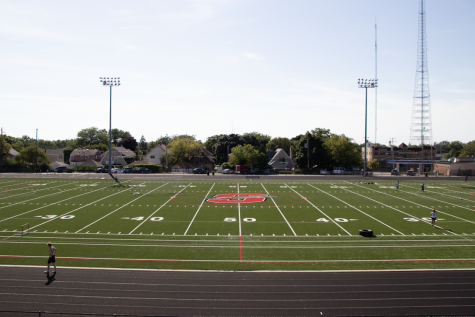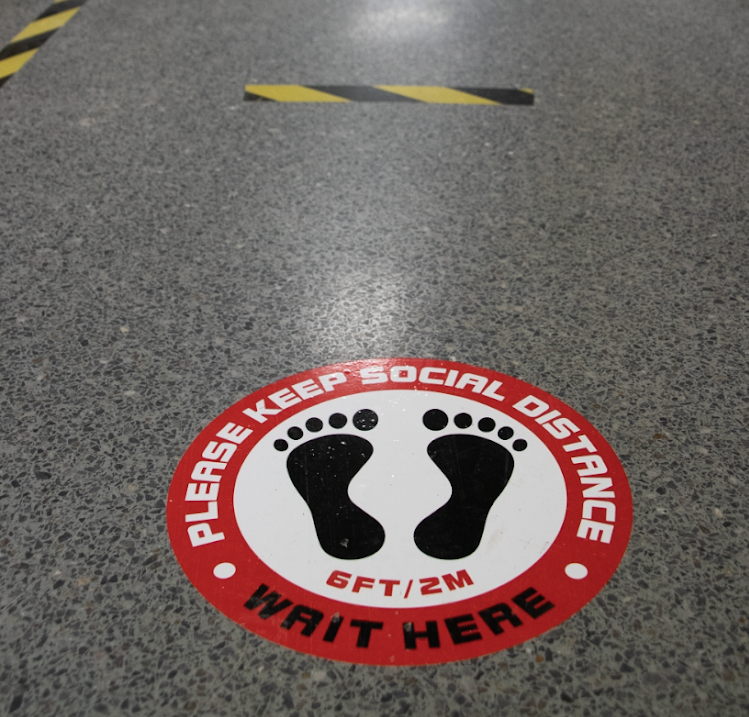School Board decides on “Virtual+” plan
Virtual+ will allow students to come in for small group work, but most learning will be online
August 21, 2020
On July 28, the school board voted 5-0 to approve an online first quarter for all district schools. School will be taught in what the district is terming a “Virtual+” model, with most of the instruction happening via online platforms, with small groups also meeting in-person to supplement the learning.
Classes will be taught via Google Classroom at the intermediate and high school, while the elementary schools will use Seesaw.
The district emphasizes that online instruction this fall will look significantly different from last spring. Two major differences will be implemented. The first is that classes will be held live, what the district is referring to as “synchronous learning.”
“One of the improvements that we’re making over last spring, which we’re really deeming ‘emergency learning’ because of how quick it was, [is that] a lot of the virtual learning training that we’re doing is going to be around synchronous learning,” said Dr. Bryan Davis, superintendent. “So we’ll have a schedule of classes [and they will] be much more structured than it was in the spring.”
Tim Kenney, SHS principal, says both students and teachers requested this change to a more synchronous learning style.
“That was a big thing that especially high school students asked for, they wanted more live contact time with teachers and … teachers were asking for that as well,” Kenney said. “And I got lots and lots of feedback from teachers that during the isolating experience for everybody that teachers really relished the time that they could have doing live meetings with students as well. And everybody’s on the same page on that one.”
The other significant difference is that some in-person learning can take place in small groups.
“School’s not closed,” Kenney said. “In the fourth quarter we were in the safer-at-home order which did not allow for people to be in the buildings except for basically essential workers, so custodial staff and other maintenance groups to keep the buildings up. That’s not the case now, where it’s not like students can’t come to school.”
Because of the major curriculum changes, teachers will have to learn new skills in order to more effectively teach online. Professional development days, which are normally scattered throughout the year, are occurring before the school year starts. This gives teachers more time to work on how they are going to teach in this new environment.
“Mickey Chavannes [director of instructional technology] and Sam Coleman [director for curriculum and instruction] are taking on new roles in terms of curriculum instruction,” said Kelsey Burke, SHS teacher and member of School Reopening Work Group. “Something that I’m looking forward to is they’re currently designing a bunch of professional development for staff … we’re already going to be learning new technologies and things like that. So it’s going to be very, very different from what we did in spring. We’re going to have more support for the staff and therefore for the students.”
There are also some changes to the school year schedule. Instead of starting on September 2, school will begin on September 9. School will finish on June 10 instead of June 9, but seniors will still end on June 6. This means there will be fewer long weekends during the school year. The number of school days in the year have not been changed.
Though the decision to go primarily online was not an easy one to make, Burke believes that the health and safety of students and faculty should remain the priority.
“I think it’s the best option we have right now,” Burke said. “It’s so much more important that our students and our staff stay healthy. There’s still a lot we don’t know about the virus. We don’t know exactly, especially for the younger kids, how they transmit it to each other or to adults. I think from what we currently know, adults are more at risk, so I’m concerned for my colleagues’ safety. I have colleagues who are unable to be in public right now because they have underlying health conditions. So even though virtual learning is going to present some challenges … I think it’s what we have to do right now just to keep everyone safe.”
Campus will be open for teachers and students
Students can work in occasional small groups, while teachers can work from their classrooms
The Virtual+ model, an adaptation of a completely virtual classroom, allows for opportunities for individual students as well as small groups to meet with their teachers or other staff in-person.
“The Virtual+ part is that in contrast to where we were in the spring, our buildings are open and we’re able to have small groups of students and staff members together, groups of 4 or 5, for example,” Davis said. “So we’ll be doing a lot of intervention work.”
Students who need extra help can come to school to work with teachers individually or in small groups. This is what the “+”, in “Virtual+”, stands for.

One of the main goals of the face-to-face interactions is to support students that faced significant challenges during the spring switch to online learning.
“We can look at our data and see students that we did not successfully engage and we did not successfully reach during our emergency learning or even when we were in school,” Coleman said. “We should be able to look at that data and then provide targeted outreach and opportunities to students and their families to say ‘We would like for your child to have access to in-person face-to-face instruction in small groups.’”
Another target group that may benefit greatly from in-person learning opportunities are the early elementary students.
“What research is telling us, and what parents are telling us, is it’s unreasonable to teach kindergarteners through second grade phonics and reading all online,” Coleman said. “That from the way the brain develops, the way the mind conceptualizes information for a four-year-old … to attempt to learn how to read virtually from a teacher or teachers, who are themselves learning how to teach virtually –– that that’s not a setup for success.”
Allowing small groups of students to meet with a teacher also expands the types of learning opportunities that can happen. For example, small groups may meet in music or performing arts classes to practice. The “+” addition also makes some lab work possible.
“That’s something that I was pushing because in a lab-based class, if you get rid of the lab part, you know…” Burke said. “Even if not everyone can come in, if you have one group or two groups working then you at least have data.”
With the buildings staying open, teachers will have the opportunity to teach from their classrooms.
“It’ll be nice to have the work-home separation,” Burke said. “There are definitely resources I can use in my classroom that I don’t have here [at home]. And I think it’s also important to still maintain that teacher-student relationship, which is something that’s going to be more difficult now with virtual learning, but just for students to see their teacher in the classroom [puts them in a mindset of] ‘Okay, I’m in school. This isn’t like school I’ve been to before, but my teacher is still in the classroom.’”
According to Coleman, having teachers in the building will be helpful in solidifying teacher-student relationships and providing students with the support they need.
“It should look like teachers and counselors and special education staff –– and even me as a director –– [are] being available and present in our offices and in our school buildings so that we can support each other and so that we can support students,” Coleman said.
While Coleman would like all teachers to teach from their classrooms, the district has decided not to make it mandatory after receiving pushback from staff.
Discussions of equity influence plan
Virtual+ plan tries to engage and support more students
In recent weeks, there have been many discussions regarding equity as it relates to online learning, as well as how it fits into the general school environment.
In response to complaints highlighting the underrepresentation of student and diverse voices, a meeting was held on July 22 to address some of the themes that had been brought up in earlier discussions. The meeting was recorded and posted to the Shorewood School District Video YouTube page, titled “School Reopening Plan Discussion on Equity Considerations.” Coleman, Shorewood Moving Forward members, teachers, school administrators, school board members and community members participated.
“The purpose of that meeting was to understand considerations for equity and then to make sure that the plan addressed those considerations,” Coleman said.
One of the things the group talked about was how “engagement” was going to be quantified during virtual learning.
“From an equity perspective, we know that not all students can participate at the scheduled times that those meetings are happening,” Coleman said. “We wanted to address the way we record and document attendance or participation in those meetings, not from a perspective of wanting to ding students for not participating, but more from a perspective of teachers and administrators being able to understand who has the opportunities to participate in those sessions. For students who we see not being able to take advantage of those scheduled opportunities, [we ask] what other supports or opportunities do we need to put in place or make available so that students can still keep up with the learning and get the support they need or teachers.”
One possibility the district is exploring is the ability to record classroom sessions and post them after the fact. This would allow for students who were not able to attend the synchronous session for whatever reason to still have access to the instruction.
“My expectation is teachers are recording their synchronous lessons and making those viewable or available on their learning management system, [either] Google Classroom or Seesaw,” Coleman said. “My expectation will be that those lessons are recorded and made available in the same way that the [equity meeting was recorded and put online]. People can go back and view that, they can rewind, they can fast forward, they can skip over.”
Coleman also recognizes, however, that posting every minute of every live class may not be feasible.
“I don’t claim to be an IT expert, so I’m assuming that that takes a huge amount of time and space in the cloud, or whatever it is, to store all these videos … I think we need to figure that out and that’s a work in progress.”
The district notes that for many families, finding childcare may be an issue, and they are therefore trying to provide accommodations.
“We’re working on a plan to be able to provide support for families that will need that supervision,” Davis said. “We have about 30% of the families in our initial survey indicated that they needed some childcare if we were in a hybrid model, so we’re assuming that if you needed it in the hybrid model you’d probably also need it the Virtual+ model. We’ll be doing another outreach to parents to get some explicit numbers on the number of kids that would be requesting for support.”
Two main obstacles that the district will have to look at are spacing and supervision.
“We’ll have to look at our square footage here on campus and all of our campuses to see where we can put students,” Davis said. “We know we have good WiFi access, that’s not an issue, but some of the issue is supervision. If we’re looking at putting four kids and an adult in a space for them to be able to do their virtual learning, looking at all of our buildings, how many kids can we actually fit.”
At the August 11 school board meeting, it was announced that the district currently has capacity to supervise 120 children grades K4-6 and 60 students in grades 7-12. More information will be sent out in the upcoming weeks detailing cost and locations.
Extracurricular activities dealt with case-by-case
Sports divided by amount of contact, performances delayed until after December
Aside from standard scholastic instruction, extracurricular activities have also been affected by the pandemic. Major performances have been put on hold.
“Both the drama department and our music department, so all of the performing arts, have pushed all of their performances back through at least December is my understanding,” Davis said. “There’ll certainly be a lot of preparation and classes will continue to go on, but as far as full-blown performances, we wanted to wait until we get to December and have an idea of where the coronavirus is at that point.”
It will be up to individual clubs to decide if and how they meet during online instruction. Students will be given an hour-long lunch, a time during which Davis suggests they may choose to meet.
“You’re going to have a lunch break during your school days, so you have an hour lunch break, that could be a time where clubs [are] meeting virtually or a small group of students could come over here,” Kenney said. “A lot of teachers have expressed that they want to teach their classes from their classrooms. We’re going to make that happen for them. They can be alone in their classrooms, safely. If the teachers are here, and so many of them are club advisors that they can… should be able to figure that all out.”
Per WIAA guidance, all sport start days have been pushed back. Sports have been split into two categories: “low-risk” including tennis, swimming, cross country and mountain biking, and “High-risk” sports such as football, soccer and volleyball.

While the WIAA oversees tournament play, it is not in charge of deciding whether regular season play continues. That is up to each individual conference.
“We’re working with our conference to see what other schools are doing, because if we don’t have a conference to play, that changes the dynamics quite a bit,” Davis said. “Although it’s nice to practice and do some team bonding, if you’re not going to play the games, is that really something that we want to do? Those are a lot of the conversations that [Levar] Ridgeway [athletics director] is having with coaches and then with other conferences as we’re moving forward.”
Sports teams will have to make changes individually to how they practice and interact, in order to adhere to social distancing guidelines and make training as safe as possible.
Gym classes will also look very different. While it hasn’t been completely figured out yet, physical education classes will likely consist of the classroom aspect and then some individual exercise component.
“It’s going to be a lot of: get your workout in, here are some exercises that you can do, log your activities, whether we have the watches to be able to monitor heart rate or whatever it is, just continuing along those lines,” Davis said. “A lot of it is probably going to be individualized workouts. Or if a couple of kids could get together and do the workout together and stay safe, that would be an opportunity, too.”
Hybrid model of learning still a possibility for the future
The Virtual+ model is scheduled until November 6, at which point the school board could potentially reevaluate their plan

While the school year is confirmed to be starting online, using the Virtual+ model until November 6, administrators, teachers and staff have been developing what a hybrid instruction model could look like.
The most likely scenario is that half the student body would attend school in-person Monday and Tuesday while the other half would watch the live sessions from home. Both groups would work online on Wednesday, and then the second half of the student population would attend school on Thursday and Friday.
This plan would have students following the same schedule as with Virtual+, with the addition of being in-person for two of the four synchronous learning days.
“We think that if we end up back in hybrid, it’s going to be really important to keep people on the same routine that they’re going to be experiencing in virtual to kind of ease people back in that way,” Kenney said.
As far as when the district will transition to hybrid learning, it’s entirely dependent on the prevalence of COVID-19. The district has identified a system of measuring the progress and spread of the virus to determine when it is safe to return to partial in-person learning that includes weekly reports from the North Shore Health Department.
“It’s all going to be working very closely with the Northshore Health Department,” Kenney said. “They’re the ones who are monitoring the situation. We’re in constant communication with them. They’ll be the ones that are able to help us.”
Administration will also be watching what happens in other school districts that are starting out in-person or in a hybrid model.
“It will also be interesting to see what happens with other school districts,” Kenney said. “Some are going to try to start the school year 100% face-to-face. I think that that’s going to cause a huge problem for them, and they’ll be virtual by the end of September. Then other school districts are going to be starting virtual and it’ll be interesting to see what happens with them, if they’re able to successfully pull it off and how they did and what’s happening with the number of positive tests.”
High school classes to be taught in longer blocks of time
Classes will be live video calls, where teachers will have to find new ways to engage students over longer class times
Room 316, normally where French and Spanish classes take place, remains empty, as it will in the fall. Teachers will have to adjust to a new teaching style, both because of online learning as well as having longer class periods.
Online school timetables will look different at each level, just as they did in-person. At the high school, classes will be taught in longer blocks of 70 minutes, with only three or four classes per day.
With longer class periods, teachers will need to find ways to engage their students beyond traditional lectures.
“The idea is that it’s not just [the student] sitting with the entire class listening to the teacher for the 70 minute period of time, but there is truly trying to get some interaction as much as we can in the large group, small group, large group, small group,” Davis said.
Exactly how that will look will depend on the teacher. Burke says she plans on spending synchronous time doing activities, saving note taking for independent learning.
“I am looking more at doing a kind of flipped classroom thing, so I’m hoping that my students will be doing more of the going through the slides and the information on their own so that when we do have our synchronous or live learning sessions we can focus on doing application stuff, working through an activity, maybe some virtual labs,” Burke said.
Aside from planning how to structure each lesson, teachers have to figure out what types of assessments they will conduct virtually. While traditional tests could still be an option, it’s easier to cheat when you’re sitting at home surrounded by technology than when you’re sitting in a classroom. One option might be to assign more projects.
“Teachers are going to need to spend some time working out what their unit tests are,” Davis said. “A lot of the assessments can be done virtually, or can be done online anyway. A lot of our textbooks have the ability to do some of those assessments online that we don’t necessarily use because it’s easier to do it face-to-face. As much as we can do online we will. Otherwise there’s going to be, you know, you continue to write papers and do some projects.”


